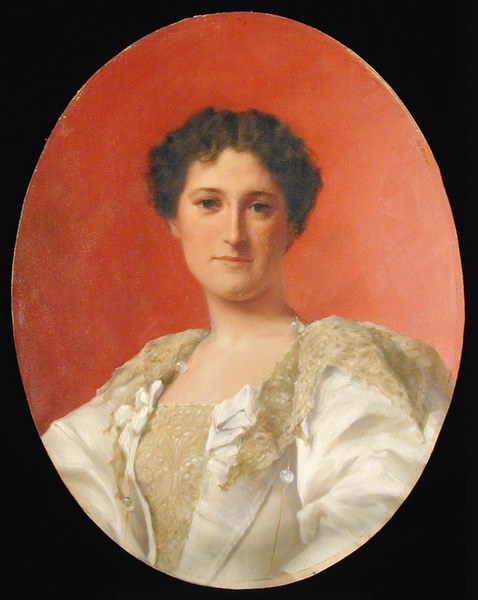Beatrix Jones Farrand (1872-1959), ca. 1895.
Beatrix Jones Farrand (1872–1959) was raised in the gilded splendor of New York’s nineteenth-century upper class. Yet Farrand eventually decided to avoid what society and the pomp and polish of the era expected of her and instead to pursue her passion for garden design, which had been kindled by childhood trips to Reef Point in Maine.
Her mother, Mary Cadwalader Jones, and her father, the handsome Frederic Rhinelander Jones, who came from a wealthy family and worked in manufacturing, divorced in 1896 after years of estrangement. The separation placed a long-standing financial burden on her and her mother. Fortunately, they maintained their relationship with Farrand’s paternal aunt, the novelist Edith Wharton. Wharton provided critically needed employment to Mary over the years as well as inspiration and encouragement to the young Farrand.
From 1893 to 1894, Farrand studied under Charles Sprague Sargent, a professor of horticulture at Harvard University and founder of Harvard’s Arnold Arboretum. An outstanding student, Farrand recognized that much of the knowledge she obtained during her time there had not been found in books. With this in mind, she toured Europe after completing her studies to gain additional insight into garden design.
To augment her limited finances, Farrand sought work as a landscape gardener. For a woman to pursue such a career was not entirely unheard of at the time; however, most found limited success in the field. Initially depending on sponsorship and commissions from wealthy family friends, Farrand soon became renowned and expanded her clientele. In 1899, she became the only female founding member of the American Society of Landscape Architects.

In 1921, Farrand first met with Mildred Barnes Bliss, who needed a landscape gardener to oversee the development of the gardens at the newly acquired Dumbarton Oaks. With overlapping social circles and similar backgrounds, Farrand and Bliss immediately took a liking to each other and became close enough in the course of their relationship to consider themselves “gardening twins.” Though certainly not Farrand’s only clients, Mildred and Robert Woods Bliss would become her close friends, and her work at Dumbarton Oaks would become one of her longest and most rewarding projects, earning her international recognition.
When Robert Bliss was appointed U.S. Minister to Sweden in 1923, the Blisses moved to Europe, leaving Farrand alone for much of the garden design process. Corresponding frequently with Mildred Bliss, Farrand continued her work, overseeing everything from the grandest conceptual schematics to the smallest aesthetic decisions. Inspired by classical Roman ideas about the purpose of gardens, Farrand and Mildred together designed many of the gardens to serve as extensions of the home living space. Accordingly, Farrand constructed enclosed garden areas for both pleasure and entertaining, allocating space in the garden plans for facilities such as a swimming pool, a tennis court, and an outdoor theater.

After the Blisses gave Dumbarton Oaks to Harvard University in 1940, the purpose and use of the estate changed dramatically. Farrand was now charged with adapting the gardens to suit institutional and public needs. At the request of John S. Thacher, the first director of Dumbarton Oaks, Farrand began work on her Plant Book in 1941. It was hoped that, with the Plant Book as a directive, proper steps could be taken by the institution and future landscape architects to preserve the original artistic spirit of the garden when Farrand’s involvement came to an end. This private manual was published in 1980, and the work reveals a deep connection between Farrand and her landscape creation, as evidenced in numerous references to individual plants and specific outlines for their care.
Approaching her seventies after nearly twenty years of work at Dumbarton Oaks, Farrand began to distance herself from the active refashioning of the gardens. Ruth Havey, a longtime member of Farrand’s staff who was familiar with Dumbarton Oaks, began to work with Mildred Bliss on new projects. By 1947, even Farrand’s advisory position for the gardens had become too much for her, and she instead devoted her time to helping Mildred Bliss assemble a garden library of rare books for Dumbarton Oaks. By the early 1950s, the library had more than tripled in size, and the Blisses donated it to Dumbarton Oaks. In 1951, they created the Garden Endowment Fund, which partly was to be used “for the maintenance and enlargement of the Garden Research Library already established at Dumbarton Oaks.” (Read more about the Garden Endowment Fund in posts about the Garden Library Rare Book Collection and the evolution of the Garden and Landscape Studies program.)
In 1950, Farrand gave Dumbarton Oaks her archive of drawings, photographs, and letters that related to the creation of the gardens. She felt that this collection was “of real value as few places have so long a carefully-kept record of attempts, accomplishments and failures. For the art of landscape these records are worthwhile and they should be kept safely, catalogued and protected.” She advised Thacher: “It is rare that a continuous history of a place covering more than 20 years is to be found. Therefore, the papers have considerable professional value. You will of course want to make this material available and useful to students of Landscape Architecture.”
After thirty years of involvement with Dumbarton Oaks, Farrand retired in 1951. She remained in close contact with the Blisses until her death in 1959. Grieving the loss of a dear friend as well as a creative collaborator, Mildred paid tribute to Farrand in a publication that she edited in 1960, Beatrix Jones Farrand, 1872–1959: An Appreciation of a Great Landscape Gardener.

